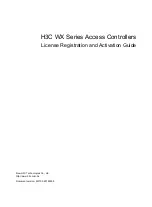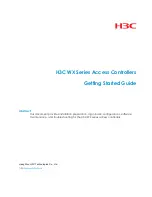
Figure 7: Correct bus termination
Sensor/Transducer Wiring
The Universal Input Module is compatible with a wide variety of electrical signal sources
including contacts, 10K thermistors, analog voltage outputs and 4–20ma current sources. Each
type of signal requires the configuration jumpers, located behind the terminal strip, to be
installed in the proper position for each type of signal. Follow the instructions below to prop-
erly wire and configure the inputs for each type of electrical signal. Note: Needlenose pliers
will be required to move the jumpers.
Warning
: The inputs are designed to work with low voltage signals from 0–5V.
DO NOT connect differential voltages greater than 5V to the inputs. DO NOT
connect 120VAC to the inputs. In the 4–20mA jumper position and when no
jumper is installed, the inputs are differential and will work with signals that
are +/-12V away from power supply ground. This allows the use of multiple
4–20mA circuits on one loop. See circuit schematics for more information.
General Wiring Considerations
Most dry contact sensors can be connected to the module using inexpensive 2-conductor cable
as small as #24 AWG. For thermistor, 0–5V and 4–20mA sensors, use the wire chart below as
a reference for selecting the appropriate wire gauge. Note that if the sensor is located far from
the module or if you are running cable in an electrically noisy environment, you should seri-
ously consider using twisted pair shielded cable. This will shield the signal from electrical inter-
ference thereby preventing false readings and/or damage to the module.
Wiring
Minimum
Distance
Wire Gauge
700'
#24 AWG
1500'
#22 AWG
2500'
#20 AWG
Normally Open/Normally Closed Dry Contacts
Dry contact sources consist of relays or switches that are isolated and have no external volt-
age applied. These devices can be connected directly to the input terminals without regard for
polarity. Choose an input and connect the wires to the corresponding screw terminals for that
input. The configuration jumper should be set to the TMP/DRY position. The figure below
shows how to connect a dry contact sensor:
23-5
Chapter 23: Universal Input Module
Содержание Sensaphone SCADA 3000
Страница 1: ...Sensaphone SCADA 3000 User s Manual Version 2 34...
Страница 6: ...vi SCADA 3000 User s Manual...
Страница 10: ...x SCADA 3000 User s Manual...
Страница 30: ...1 6 SCADA 3000 User s Manual...
Страница 48: ...4 6 SCADA 3000 User s Manual...
Страница 70: ...9 8 SCADA 3000 User s Manual...
Страница 122: ...12 8 SCADA 3000 User s Manual...
Страница 190: ...15 30 SCADA 3000 User s Manual...
Страница 211: ...lead 1 lag 0 else lead 0 lag 1 16 21 Chapter 16 Programming in C...
Страница 212: ...16 22 SCADA 3000 User s Manual...
Страница 236: ...21 8 SCADA 3000 User s Manual...
Страница 248: ...22 12 SCADA 3000 User s Manual...
Страница 258: ...23 10 SCADA 3000 User s Manual...
Страница 274: ...25 8 SCADA 3000 User s Manual...
Страница 288: ...27 8 SCADA 3000 User s Manual...
Страница 294: ...28 6 SCADA 3000 User s Manual...
Страница 296: ...A 2 SCADA 3000 User s Manual...
Страница 302: ...D 2 SCADA 3000 User s Manual...
Страница 318: ...I 2 SCADA 3000 User s Manual...
Страница 320: ...J 2 SCADA 3000 User s Manual...
Страница 322: ...K 2 SCADA 3000 User s Manual...
Страница 335: ...Test Log...
Страница 336: ......
















































